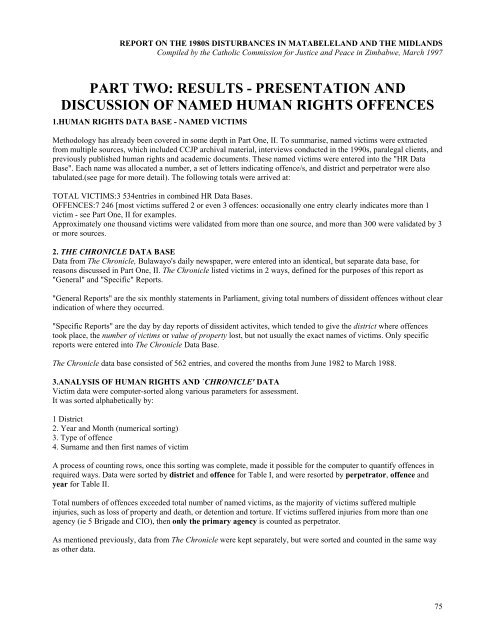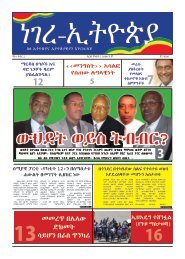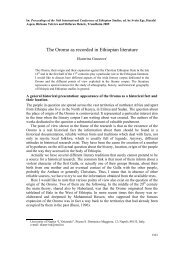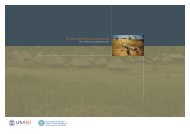MatabelelandReport
MatabelelandReport
MatabelelandReport
You also want an ePaper? Increase the reach of your titles
YUMPU automatically turns print PDFs into web optimized ePapers that Google loves.
REPORT ON THE 1980S DISTURBANCES IN MATABELELAND AND THE MIDLANDS<br />
Compiled by the Catholic Commission for Justice and Peace in Zimbabwe, March 1997<br />
PART TWO: RESULTS - PRESENTATION AND<br />
DISCUSSION OF NAMED HUMAN RIGHTS OFFENCES<br />
1.HUMAN RIGHTS DATA BASE - NAMED VICTIMS<br />
Methodology has already been covered in some depth in Part One, II. To summarise, named victims were extracted<br />
from multiple sources, which included CCJP archival material, interviews conducted in the 1990s, paralegal clients, and<br />
previously published human rights and academic documents. These named victims were entered into the "HR Data<br />
Base". Each name was allocated a number, a set of letters indicating offence/s, and district and perpetrator were also<br />
tabulated.(see page for more detail). The following totals were arrived at:<br />
TOTAL VICTIMS:3 534entries in combined HR Data Bases.<br />
OFFENCES:7 246 [most victims suffered 2 or even 3 offences: occasionally one entry clearly indicates more than 1<br />
victim - see Part One, II for examples.<br />
Approximately one thousand victims were validated from more than one source, and more than 300 were validated by 3<br />
or more sources.<br />
2. THE CHRONICLE DATA BASE<br />
Data from The Chronicle, Bulawayo's daily newspaper, were entered into an identical, but separate data base, for<br />
reasons discussed in Part One, II. The Chronicle listed victims in 2 ways, defined for the purposes of this report as<br />
"General" and "Specific" Reports.<br />
"General Reports" are the six monthly statements in Parliament, giving total numbers of dissident offences without clear<br />
indication of where they occurred.<br />
"Specific Reports" are the day by day reports of dissident activites, which tended to give the district where offences<br />
took place, the number of victims or value of property lost, but not usually the exact names of victims. Only specific<br />
reports were entered into The Chronicle Data Base.<br />
The Chronicle data base consisted of 562 entries, and covered the months from June 1982 to March 1988.<br />
3.ANALYSIS OF HUMAN RIGHTS AND `CHRONICLE' DATA<br />
Victim data were computer-sorted along various parameters for assessment.<br />
It was sorted alphabetically by:<br />
1 District<br />
2. Year and Month (numerical sorting)<br />
3. Type of offence<br />
4. Surname and then first names of victim<br />
A process of counting rows, once this sorting was complete, made it possible for the computer to quantify offences in<br />
required ways. Data were sorted by district and offence for Table I, and were resorted by perpetrator, offence and<br />
year for Table II.<br />
Total numbers of offences exceeded total number of named victims, as the majority of victims suffered multiple<br />
injuries, such as loss of property and death, or detention and torture. If victims suffered injuries from more than one<br />
agency (ie 5 Brigade and CIO), then only the primary agency is counted as perpetrator.<br />
As mentioned previously, data from The Chronicle were kept separately, but were sorted and counted in the same way<br />
as other data.<br />
75







